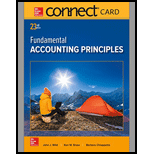
Asset:
An asset means a possession of property tangible or intangible which has some value; such that it can be realized in monetary terms and such asset can be liquidated in short-term or long-term approach so as to derive its value in cash.
Current Assets:
A current asset can be as the asset of any entity that is in the form of cash, cash equivalent or in a form which can be converted into cash within a year. Generally the current are defined to be the ones which can be liquidated within a year but if the company's operating cycle exceeds one year even though the assets are regarded as current assets until they get converted into cash ultimately as the last stage of operating cycle.
Long-Term Assets:
Long-term assets are the assets possessed by the company which cannot be liquidated before one year. The minimum maturity period for the said assets is one year. These assets are being recorded in the books at the purchase price and are adjusted by the
To determine: The difference between land and land improvements.
Want to see the full answer?
Check out a sample textbook solution
Chapter 10 Solutions
Connect Access Card for Fundamental Accounting Principles
- What is the differential revenue from the acceptance of the offer?arrow_forwardHow does dollar-value LIFO differ from traditional LIFO in accounting records? (A) Uses different cost flow assumption (B) Applies only to specific industries (C) Required for tax purposes (D) Pools inventory by dollars not units Answerarrow_forwardI need help solving this general accounting question with the proper methodology.arrow_forward

 AccountingAccountingISBN:9781337272094Author:WARREN, Carl S., Reeve, James M., Duchac, Jonathan E.Publisher:Cengage Learning,
AccountingAccountingISBN:9781337272094Author:WARREN, Carl S., Reeve, James M., Duchac, Jonathan E.Publisher:Cengage Learning, Accounting Information SystemsAccountingISBN:9781337619202Author:Hall, James A.Publisher:Cengage Learning,
Accounting Information SystemsAccountingISBN:9781337619202Author:Hall, James A.Publisher:Cengage Learning, Horngren's Cost Accounting: A Managerial Emphasis...AccountingISBN:9780134475585Author:Srikant M. Datar, Madhav V. RajanPublisher:PEARSON
Horngren's Cost Accounting: A Managerial Emphasis...AccountingISBN:9780134475585Author:Srikant M. Datar, Madhav V. RajanPublisher:PEARSON Intermediate AccountingAccountingISBN:9781259722660Author:J. David Spiceland, Mark W. Nelson, Wayne M ThomasPublisher:McGraw-Hill Education
Intermediate AccountingAccountingISBN:9781259722660Author:J. David Spiceland, Mark W. Nelson, Wayne M ThomasPublisher:McGraw-Hill Education Financial and Managerial AccountingAccountingISBN:9781259726705Author:John J Wild, Ken W. Shaw, Barbara Chiappetta Fundamental Accounting PrinciplesPublisher:McGraw-Hill Education
Financial and Managerial AccountingAccountingISBN:9781259726705Author:John J Wild, Ken W. Shaw, Barbara Chiappetta Fundamental Accounting PrinciplesPublisher:McGraw-Hill Education





